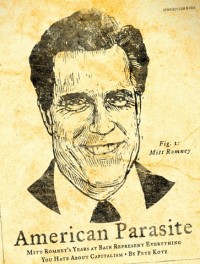BLOOMBERG NEWS: In 1992, Bain Capital bought American Pad & Paper by financing 87 percent of the purchase price. In the next three years, Ampad borrowed to make acquisitions, repay existing debt and pay Bain Capital and its investors $60 million in dividends. As a result, the company’s debt swelled from $11 million in 1993 to $444 million by 1995. The $14 million in annual interest expense on this debt dwarfed the company’s $4.7 million operating cash flow. The proceeds of an initial public offering in July 1996 were used to pay Bain Capital $48 million for part of its stake and to reduce the company’s debt to $270 million.
From 1993 to 1999, Bain Capital charged Ampad about $18 million in various fees. By 1999, the company’s debt was back up to $400 million. Unable to pay the interest costs and drained of cash paid to Bain Capital in fees and dividends, Ampad filed for bankruptcy the following year. Senior secured lenders got less than 50 cents on the dollar, unsecured lenders received two- tenths of a cent on the dollar, and several hundred jobs were lost. Bain Capital had reaped capital gains of $107 million on its $5.1 million investment. Bain Capital’s acquisition in 1994 of Dade International, a supplier of in-vitro diagnostic products, was 81 percent financed by debt. Of the $85 million in equity, about $27 million came from Bain with the rest coming from a group of investors that included Goldman Sachs Group Inc.
From 1995 to 1999, Bain Capital tripled Dade’s debt from about $300 million to $902 million. Some of the debt was used to pay for acquisitions of DuPont Co.’s in-vitro diagnostics division in May 1996 and Behring Diagnostics, a  German medical- testing company, in 1997. But some was used to finance a repurchase of half of Bain Capital’s equity for $242 million — more than eight times its investment — and to pay its investors almost $100 million in fees. Dade was left in a weakened financial condition and couldn’t withstand the shocks of increased debt payments when interest rates rose and revenue from Europe fell because of a decline in the value of the euro. The company filed for bankruptcy in August 2002, because of its inability to service a $1.5 billion debt load. About 1,700 people lost their jobs while Bain Capital claimed capital gains (net of its losses in the bankruptcy) of roughly $216 million, an eightfold return. MORE
German medical- testing company, in 1997. But some was used to finance a repurchase of half of Bain Capital’s equity for $242 million — more than eight times its investment — and to pay its investors almost $100 million in fees. Dade was left in a weakened financial condition and couldn’t withstand the shocks of increased debt payments when interest rates rose and revenue from Europe fell because of a decline in the value of the euro. The company filed for bankruptcy in August 2002, because of its inability to service a $1.5 billion debt load. About 1,700 people lost their jobs while Bain Capital claimed capital gains (net of its losses in the bankruptcy) of roughly $216 million, an eightfold return. MORE
NEW YORK TIMES: Mr. Romney’s descriptions of when he left Bain have been erratic and self-serving. In 2002, when he needed to show he was still a Massachusetts resident, he denied he had quit in 1999, saying he had taken a leave of absence to run the Olympics committee. A series of documents filed with the Securities and Exchange Committee show that Bain certainly didn’t describe him as absent after 1999. A former Bain managing director, Edward Conard, said on MSNBC Sunday that Mr. Romney remained C.E.O. “legally” so he could negotiate his generous exit deal. But now that Bain has been accused of helping other companies outsource jobs overseas, laying off steel company employees and wiping out their pensions, Mr. Romney says he had no management role after 1999. A Kansas City steel plant that Bain bought in 1993 under Mr. Romney’s control, for example, went bankrupt in 2001, costing 750 workers their jobs and pensions. After the Obama campaign made an ad featuring several of the angry workers, the Romney campaign said he couldn’t be blamed because he left Bain in 1999. MORE

